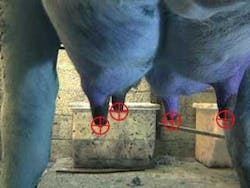Robotics heralds new era in dairy farming
The first fully automated robotic milking stall was introduced in The Netherlands in 1992. The robot system enabled "self-service milking" by cows, where the milking robot is accessible by the cow without the need for a farmer to be present. Such use of robotics promises increased milk yields and reduced labor requirements.
According to Andrew Peacock, managing director of IceRobotics Ltd. (Edinburgh, Scotland; www.icerobotics.co.uk), this approach to dairy farming has already been proven to increase the cow's milk yield by as much as 20% as a result of milking three or four times each day instead of twice. Many farming analysts are predicting a dramatic move to robotics on dairy farms over the forth-coming decade. Already, nearly 2000 farms worldwide have installed a robot milking system.
Existing milking robots use laser-scanning technology to locate the cow's teats and then guide a conventional robot mechanism to attach automated milking cups. However, the dairy setting starkly contrasts with the controlled environments of manufacturing plants in which conventional robot systems have evolved. Such robot technology has a difficult transition into dairy-farm environments because of vulnerability to dirt, dust, and fluids, as well as the need for expensive adaptation to minimize animal injury, the requirements for regular ongoing maintenance, and the low costs demanded by farmers.
Recently, IceRobotics was approached by the milking equipment industry to develop automated milking robots. After a study period, IceRobotics selected stereo-vision technology to provide 3-D position-coordinate data. According to Oliver Lewis, project manager, a laser helps position and attach the suction cup mechanism. To position the milking cups, the robot only requires millimeter accuracy, rather than the submicron accuracy many laser systems can achieve.
The stereo-vision system uses a pair of calibrated CMOS image sensors to locate and track natural point targets. This technology has been adapted to millimeter accuracy at 10 Hz. Lewis sees further possibilities for the sensors, "One disadvantage of fully automated milking is that interaction between farmer and cow is reduced, making it harder to detect and treat sick animals at an early stage. By putting cameras into the system, automatic inspection can also be used to look for cuts and malformations, which are key elements in supporting animal health and welfare.
The robot milking arm was developed at Heriot-Watt University (Edinburgh, Scotland; www.hw.ac.uk) by Bruce Davies, founder of IceRobotics. In conjunction with its CMOS sensor-based systems, IceRobotics is developing its Mimetix actuator for robot systems that will allow milking robots to perform additional tasks such as cow cleaning prior to milking, the placing and removal of milk cups, and postmilking disinfection. And because biometric components need to be replaceable at low cost, robot arms and end-effectors may become disposable items.

